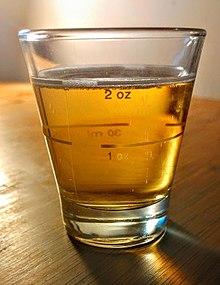Fluid ounce
| Fluid ounce | |
|---|---|
 An example of a 2 fl oz shot glass in British Imperial fluid ounces | |
| General information | |
| Unit system | Imperial units, US customary units |
| Unit of | Volume |
| Symbol | fl oz |
| Conversions (imperial) | |
| 1 imp fl oz in ... | ... is equal to ... |
SI units | 28.41306 ml |
US customary units | 0.9607599 US fl oz |
| Conversions (US) | |
| 1 US fl oz in ... | ... is equal to ... |
SI units | 29.57353 ml |
Imperial units | 1.040843 imp fl oz |
| Look up fluid ounce in Wiktionary, the free dictionary. |
A fluid ounce (abbreviated fl oz, fl. oz. or oz. fl., old forms ℥, fl ℥, f℥, ƒ ℥) is a unit of volume (also called capacity) typically used for measuring liquids. Various definitions have been used throughout history, but only two are still in common use: the British Imperial and the United States customary fluid ounce.
An imperial fluid ounce is 1⁄20 of an imperial pint, 1⁄160 of an imperial gallon or approximately 28.41 ml.
A US fluid ounce is 1⁄16 of a US fluid pint and 1⁄128 of a US liquid gallon or approximately 29.57 ml, making it about 4% larger than the imperial fluid ounce.
The fluid ounce is distinct from the ounce as a unit of weight or mass, although it is sometimes referred to simply as an "ounce" where context makes the meaning clear, such as ounces in a bottle.
History
The fluid ounce was originally the volume occupied by one ounce of some substance, such as wine (in England) or water (in Scotland). The ounce in question varied depending on the system of fluid measure, such as that used for wine versus ale. Various ounces were used over the centuries, including the Tower ounce, troy ounce, avoirdupois ounce, and various ounces used in international trade, such as Paris troy. The situation is further complicated by the medieval practice of "allowances", whereby a unit of measure was not necessarily equal to the sum of its parts. For example, the 364-pound woolsack (165 kg) had a 14-pound allowance (6.4 kg) for the weight of the sack and other packaging materials.[1]
In 1824, the British Parliament defined the imperial gallon as the volume of ten pounds of water at standard temperature.[2] The gallon was divided into four quarts, the quart into two pints, the pint into four gills, and the gill into five ounces. Thus, there were 160 imperial fluid ounces to the gallon making the mass of a fluid ounce of water approximately one avoirdupois ounce (28.4 g). This relationship is still approximately valid even though the imperial gallon's definition was later revised to be 4.54609 litres, making the imperial fluid ounce exactly 28.4130625 ml.
The US fluid ounce is based on the US gallon, which is based on the wine gallon of 231 cubic inches that was used in England prior to 1824. With the adoption of the international inch, the US fluid ounce became 29.5735295625 ml exactly, or about 4% larger than the imperial unit.
Definitions and equivalences
- Imperial fluid ounce
1 imperial fluid ounce = 1⁄160 imperial gallon = 1⁄40 imperial quart = 1⁄20 imperial pint = 1⁄10 imperial cup = 1⁄5 imperial gill = 8 imperial fluid drams = 28.4130625
millilitres[3]≈ 1.733871455 cubic inches ≈ 0.960759940 US fluid ounces ≈ the volume of 1 avoirdupois ounce of water[2]
- US customary fluid ounce
1 US fluid ounce = 1⁄128 US gallon = 1⁄32 US quart = 1⁄16 US pint = 1⁄8 US cup = 1⁄4 US gill = 2
US tablespoons= 6
US teaspoons= 8 US fluid drams = 1.8046875 cubic inches[4] = 29.5735295625 millilitres ≈ 1.040842731 imperial fluid ounces
- US food labelling fluid ounce
- US regulation 21 CFR 101.9(b)(5)(viii) also defines a fluid ounce as exactly 30 millilitres, but this is for use in nutrition labelling only.[5]
30 millilitres ≈ 1.055852392 imperial fluid ounces[3] ≈ 1.014420681 US customary fluid ounces[4] ≈ 1.830712323 cubic inches
References and notes
^ Connor, R. D.; Simpson, Allen David Cumming; Morrison-Low, A. D.; National Museums of Scotland (2004). Weights and measures in Scotland: a European perspective. NMS. p. 153. ISBN 978-1-901663-88-4. Retrieved 21 September 2012..mw-parser-output cite.citationfont-style:inherit.mw-parser-output .citation qquotes:"""""""'""'".mw-parser-output .citation .cs1-lock-free abackground:url("//upload.wikimedia.org/wikipedia/commons/thumb/6/65/Lock-green.svg/9px-Lock-green.svg.png")no-repeat;background-position:right .1em center.mw-parser-output .citation .cs1-lock-limited a,.mw-parser-output .citation .cs1-lock-registration abackground:url("//upload.wikimedia.org/wikipedia/commons/thumb/d/d6/Lock-gray-alt-2.svg/9px-Lock-gray-alt-2.svg.png")no-repeat;background-position:right .1em center.mw-parser-output .citation .cs1-lock-subscription abackground:url("//upload.wikimedia.org/wikipedia/commons/thumb/a/aa/Lock-red-alt-2.svg/9px-Lock-red-alt-2.svg.png")no-repeat;background-position:right .1em center.mw-parser-output .cs1-subscription,.mw-parser-output .cs1-registrationcolor:#555.mw-parser-output .cs1-subscription span,.mw-parser-output .cs1-registration spanborder-bottom:1px dotted;cursor:help.mw-parser-output .cs1-ws-icon abackground:url("//upload.wikimedia.org/wikipedia/commons/thumb/4/4c/Wikisource-logo.svg/12px-Wikisource-logo.svg.png")no-repeat;background-position:right .1em center.mw-parser-output code.cs1-codecolor:inherit;background:inherit;border:inherit;padding:inherit.mw-parser-output .cs1-hidden-errordisplay:none;font-size:100%.mw-parser-output .cs1-visible-errorfont-size:100%.mw-parser-output .cs1-maintdisplay:none;color:#33aa33;margin-left:0.3em.mw-parser-output .cs1-subscription,.mw-parser-output .cs1-registration,.mw-parser-output .cs1-formatfont-size:95%.mw-parser-output .cs1-kern-left,.mw-parser-output .cs1-kern-wl-leftpadding-left:0.2em.mw-parser-output .cs1-kern-right,.mw-parser-output .cs1-kern-wl-rightpadding-right:0.2em
^ ab The imperial gallon was originally defined as the volume occupied by ten avoirdupois pounds (4.54 kg) of distilled water weighed in air with brass weights with the barometer standing at 30 inches of mercury (102 kPa) at a temperature of 62 °F (16.7 °C).
^ ab "The Units of Measurement Regulations 1995 (Schedule)". 20 September 2000. Retrieved 18 April 2006.
^ ab One US gallon is defined as 231 cubic inches.
^ "Food and Drug Administration, HHS" (PDF). Retrieved 18 April 2006.